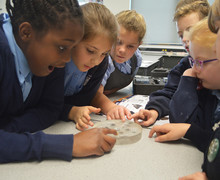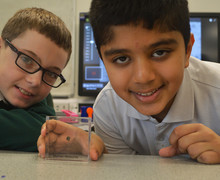Children touch the actual moon
Back to News
Students are reaching for the stars...and touching the moon.
Children attending BMAT schools in Harlow have been given a once-in-a-lifetime experience thanks to BMAT STEM Academy.
The school – dedicated to science, technology, engineering and maths – is one of the select few in the country to borrow a piece of the moon.
Working with the Science and Technology Facilities Council, the school took part in the Lunar Rocks and Meteorites Loan Scheme which enabled it to borrow NASA moon rock discs and meteorites for five days.
Students from BMAT STEM, Burnt Mill Academy, Roydon Primary Academy and Cooks Spinney Primary Academy all got the chance to work with the samples.
Kendra Paho, Year 5 pupil from Roydon, said: “It has been really interesting and cool. We got to see the moon right in front of us and find out more information about it. It was fascinating.”
Michael Clark, headteacher at Roydon, said: “We always love to offer the children the best possible life experiences and to see a part of the moon was one the children loved. We want to thank BMAT STEM Academy for having us again. The children took a lot from the morning.”
Year 10 GCSE astronomy students from BMAT STEM used the visit of the meteorites and samples brought back from Apollo missions to enhance their studies.
Paul Andrew, assistant head and science teacher at BMAT STEM, said: “The main reason we wanted to take part was for our astronomy students to be able to look at moon-based rock which they would not otherwise get to see. They have been able to handle it for themselves which helps to give their studies context.
“These samples have come all the way from the moon which is an absolute wow moment for them. The samples are irreplaceable and priceless.
“It has been brilliant to share this with students. It has been lovely to see them so interested and engaged and doing something different. Seeing the way the children reacted to it really brought science alive. That is what it is about for me, making science real while doing something they can enjoy. One primary school pupil said she didn’t want to leave!”
Secondary school students looked at the samples under a microscope, while primary school pupils learnt how to differentiate between earth and space-bound rocks using their science knowledge.


